 |
|
Sony's Bernstein Century CDs include many of Leonard Bernstein's famed Columbia recordings omitted from the previous Royal Edition. Here's a survey of the performances that are new to CD.
|
|
Sometimes they only respect you when you're gone. At least that's how Sony seems to have treated the richest segment of its inherited Columbia catalog - the Leonard Bernstein legacy.
 Younger collectors are most familiar with the final phase of Bernstein's conducting career - live concerts that seethed with deep personal emotion, released by Deutsche Grammophon since the mid-'seventies. Over the previous quarter-century, though, he had cut hundreds of works for Columbia, mostly as the permanent conductor of the New York Philharmonic. These are perhaps the most vital part of Bernstein's artistic legacy, as they preserve a fine balance between youthful exploration and mature understanding. Younger collectors are most familiar with the final phase of Bernstein's conducting career - live concerts that seethed with deep personal emotion, released by Deutsche Grammophon since the mid-'seventies. Over the previous quarter-century, though, he had cut hundreds of works for Columbia, mostly as the permanent conductor of the New York Philharmonic. These are perhaps the most vital part of Bernstein's artistic legacy, as they preserve a fine balance between youthful exploration and mature understanding.
In his final years, with DG pouring out those glorious valedictory concert records, Sony seemed reluctant to reissue Bernstein's earlier work and released only sporadic volumes scattered among its generic CD lines. Then from 1992 through 1994 came the posthumous 100-volume "Royal Edition." Although Lenny's legions of fans eagerly snapped it up, many were appalled at the absurd attempt to link our supreme multi-talented American genius with His Royal Highness Prince Charles, under whose auspices the CDs were ostensibly issued (to pay Bernstein the respect he deserved, according to the liner notes). But such patronage was hardly necessary to validate affection for one of the most beloved and influential musicians of all time.
Now Sony has launched a new retrospective - the "Bernstein Century." It's unclear whether their motivation was to make amends for the foolish conceit of their Royal blunder or simply to squeeze more profit from a legendary cash cow. Beyond wiping HRH's gratuitous portrait and vapid watercolors off the covers and replacing the generic Royal essays with cogent liner notes, it's clear that this time Sony is at least trying to do it right.
Of the CDs released so far, nearly half replace volumes of the Royal set. Of those, some perpetuate essential Bernstein, especially his Mahler, Ives, Gershwin and Copland, while others simply cater to mass marketing - Vivaldi's Four Seasons, Holst's Planets, Tchaikovsky ballets and a collection of marches. Some of the replacements boast improved sonics (24-bit processing, rather than a mere 20), but, the compressed dynamic range and blurred instrumental timbres of the ones I've compared sound considerably cruder than their Royal counterparts. Indeed, some noticeably degrade the original LPs which, at least until the mid-'sixties, boasted an openness and clarity that the new marvels simply don't capture. Sorry, Sony, but that ain't progress.
The true value of the new edition is the release of nearly all the unique and distinctive Bernstein performances that the Royal Edition bypassed in favor of his redundant renditions of light classics and mainstream repertoire. While it was nice to have Lenny's versions of Beethoven, Brahms, Tchaikovsky and Wagner on CD, they added little to the greater insight of other conductors.
The greatest bounty is the modern music which Bernstein so ardently championed. Especially welcome are restorations of Bernstein's seminal readings of Charles Ives' Holidays and symphonies of William Schuman, Harold Shapero, Roy Harris, Randall Thompson and David Diamond. Also welcome are Samuel Barber's Violin Concerto and Aaron Copland's Piano Concerto, Music for the Theatre and Organ Symphony. Incidentally, while these were all written well into the 20th century, they're solidly tonal and shouldn't offend traditional ears; for more radical tastes, there's Eliott Carter's spiky Concerto For Orchestra, Copland's aggressive Connotations and Lukas Foss's improvisatory Time Cycle.
Rock fans will especially enjoy Claude Debussy's rarely-heard 1910 Saxophone Rhapsody, one of the earliest attempts to infuse jazz into serious music, which nestles the rude honker in an unaccustomed air of pastoral sensitivity. And don't miss Ives's Unanswered Question, a unique and unforgettable work that says more about the human condition in six elegant minutes than Wagner managed in a lifetime.
Bernstein was widely hailed as a great Mahler conductor and the Bernstein Century restores his sensational 1963 reading of the Symphony # 2 ("Resurrection"). Other fine performances of the romantic repertoire which the Royal Edition had overlooked include Berlioz's Harold in Italy, Dvorak's Symphony # 7, Respighi's Pines of Rome and Roman Festivals and Honegger rhythmic studies.
Dipping back further into history, we get first CD releases of Bach and Mozart concerti, a Mozart quartet, the rarely-heard Handel Ode for St. Cecilia's Day and spirited arrangements of Handel's Messiah and Bach's St. Matthew Passion (sung in English). All are further tributes to the depth of Bernstein's wide-ranging talents, both as conductor and pianist.
The only disaster is Debussy's Martyrdom of St. Sebastian. And yet, it's a fascinating failure, as it exemplifies at once both the vision and crudeness that made Bernstein unique. The concept was tantalizing -- a bold and vivid updating of Debussy's incidental music to a mystery play, transfused by Bernstein's essential energy into striking modern drama. But not content with transmuting the music, Bernstein felt compelled to add trite narration screamed by two speakers whose hysterical emoting ruins the subtle wonder and awe of the original (beautifully conveyed in the version spoken and conducted by Charles Munch on RCA 60684). Suffering from the same enervating excess as his contemporaneous "Kaddish" Symphony, the result is downright embarrassing.
The crowning glory here is Bernstein's own 1971 Mass, which surely stands as his artistic testament. Most of the criticism is true enough - the overall concept of using Catholic ritual to explore our modern spiritual crisis ("I believe in God, but does God believe in me?") is pretentious and unwieldy, the theology is shallow and patronizing, and portions are overblown and mawkish. And yet, Mass is a stunning profusion of musics and moods - orchestral meditations, marches, opera arias, show tunes, blues, hymns, gospel, folk, rounds, electronic dissonance - all unified and vitalized by Bernstein's overwhelming humanism and staggering creativity. Even the rhythms are unconventional, with many sections written in meters of 5 or 7 (a mock-gospel sermon even alternates sections of 7 and 9-1/2!).
That one man could be so thoroughly conversant with so many disparate musical styles and could blend them all together with such consummate ease is the ultimate testament to Bernstein's eclectic genius. Despite all the secular elements, the lasting impression is profoundly religious, exalting the joy, probing the challenges and, in one of the most moving endings ever written, ultimately hallowing the timeless comfort and peace of pure and sincere faith. While the Bernstein Century restores Bernstein's definitive readings of many of his other works (including his startling first opera, Trouble in Tahiti, his under-appreciated Dybbuk ballet and the original version of his Symphony # 2), Mass is the ultimate distillation of his prodigious talent, the artistic bequest of a man who spent his life storming the barricades of classical routine and pouring into his music his huge love of humanity. If I had to choose a single example of Bernstein's legacy, it would have to be Mass.
In another decade, with the Royal Edition long forgotten and the Bernstein Century poised for deletion, will Sony launch yet another run at the Bernstein catalog - perhaps a Bernstein Millennium series with hundred-bit processing? Or perhaps they'll wait until we can replace all our Bernstein CDs with chips? But remuneration aside, all this incessant recycling really stands as a tribute to the lasting power of a truly great and unforgettable musician, whose fabulous work and spirit should be kept alive for future ages. Having been so vitally concerned with inspiring new generations with a passion for classical music, Bernstein himself surely would have wanted it that way.
= = = = = = = = = = = =
In the expanded version of this column, I'd like to consider the individual volumes of the Bernstein Century edition released to date. I'm omitting those which primarily serve to reissue works already in the Royal Edition on the assumption that if you love Bernstein you already have them; unless you simply can't bear the sight of HRH a moment longer, there's no reason to duplicate, especially given the depreciated sound quality of the new edition. Here they are, in approximately chronological order of the lead composition. I've provided recording dates to distinguish remakes. All are with the New York Philharmonic, unless indicated otherwise:
- Bach: St. Matthew Passion, with David Lloyd, William Wildermann, Donald Bell, Adele Addison, Betty Allen, Charles Bressler, the Collegiate Chorale and the Boys' Choir of the Church of the Transfiguration (SM2K 60727).
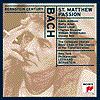 Heavily cut to 2-1/2 hours and sung in English translation, this is still a wonderful recording - lush, heartfelt, dramatic, beautiful, warm and intensely human. This is Bernstein the great educator, trying to render the wonder of Bach's towering masterpiece accessible without cheapening it. Filling out disc 2 is one of Bernstein's marvelous lectures in which his enthusiasm for the work is palpable and, more important, still quite contagious. Heavily cut to 2-1/2 hours and sung in English translation, this is still a wonderful recording - lush, heartfelt, dramatic, beautiful, warm and intensely human. This is Bernstein the great educator, trying to render the wonder of Bach's towering masterpiece accessible without cheapening it. Filling out disc 2 is one of Bernstein's marvelous lectures in which his enthusiasm for the work is palpable and, more important, still quite contagious.
- Bach: Piano Concerto # 1, with Glenn Gould; Violin Concerto # 2, with Isaac Stern; Concerto for Oboe and Violin, with Harold Gomberg and Isaac Stern; Vivaldi: Concerto for Piccolo, RV 443, with William Heim (SMK 60211).
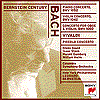 All these performances are smooth, elegant and well-proportioned, if without the precise articulation to which original instrument ensembles have now accustomed us. Especially magnificent is the piano concerto, idiomatic but full of Gould's personal brand of drama. All these performances are smooth, elegant and well-proportioned, if without the precise articulation to which original instrument ensembles have now accustomed us. Especially magnificent is the piano concerto, idiomatic but full of Gould's personal brand of drama.
- Handel: The Messiah, with Adele Addison, Russell Oberlin, David Lloyd, William Warfield and the Westminster Choir (SM2K 60205).
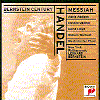 In the original album notes, Bernstein took the bull by the horns and disarmingly justified his controversial restructuring as "offered in the spirit of deep love for the music and reverence for its textual significance, combined with the joy of a fresh approach." Purists were appalled at his excising a half-hour of music and recasting the rest of the three parts into two, forming a "Christmas" section of Part 1 and the second half of Part 2 (with intermission following the awesome "Hallelujah Chorus") and folding the rest of Part 2 into to the middle of Part 3 to form an "Easter" section. Nowadays, we're spoiled by innumerable "authentic" presentations, and Bernstein's many liberties of structure, tempo, voicing (replacing the contralto with a countertenor) and unfettered feeling may evoke even less sympathy than they did forty years ago. And yet, this remains a magnificent realization and as valid as any -- unconventional, perhaps, but emotionally satisfying and well within the Handelian spirit. As Bernstein points out, Handel himself constantly adapted his works for new performances and there is no such thing as a definitive version. In the original album notes, Bernstein took the bull by the horns and disarmingly justified his controversial restructuring as "offered in the spirit of deep love for the music and reverence for its textual significance, combined with the joy of a fresh approach." Purists were appalled at his excising a half-hour of music and recasting the rest of the three parts into two, forming a "Christmas" section of Part 1 and the second half of Part 2 (with intermission following the awesome "Hallelujah Chorus") and folding the rest of Part 2 into to the middle of Part 3 to form an "Easter" section. Nowadays, we're spoiled by innumerable "authentic" presentations, and Bernstein's many liberties of structure, tempo, voicing (replacing the contralto with a countertenor) and unfettered feeling may evoke even less sympathy than they did forty years ago. And yet, this remains a magnificent realization and as valid as any -- unconventional, perhaps, but emotionally satisfying and well within the Handelian spirit. As Bernstein points out, Handel himself constantly adapted his works for new performances and there is no such thing as a definitive version.
- Handel: Ode for St. Cecelia's Day,with Adele Addison, John McCollum and the Rutgers University Choir (SMK 60731).
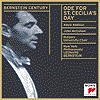 Written for the 1739 annual festival honoring the patron sainte of music, Handel's Ode deserves far better than its current obscurity. Despite uninspired text by John Dryden, it's full of engaging music that exemplifies the splendor of baroque, infused here by Bernstein's ardent romantic sensibility. The slow, quiet passages in particular are ravishing and sensual. Truth to tell, though, some of the brighter sections seem a bit anemic. A great discovery. Written for the 1739 annual festival honoring the patron sainte of music, Handel's Ode deserves far better than its current obscurity. Despite uninspired text by John Dryden, it's full of engaging music that exemplifies the splendor of baroque, infused here by Bernstein's ardent romantic sensibility. The slow, quiet passages in particular are ravishing and sensual. Truth to tell, though, some of the brighter sections seem a bit anemic. A great discovery.
- Mozart: Concerto for Two Pianos, with Arthur Gold and Robert Fizdale, Concerto for Three Pianos, with Bernstein, Gold and Fizdale; Piano Quartet, K. 478, with Bernstein, Julliard Quartet (SMK 60598).
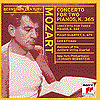 There are lots of fine (and, frankly, more interesting) records of the concertos. The quartet, though, is special, as it affords a rare glimpse of Bernstein in chamber music. The performance is sharp and alive, yet sensitive and gentle, fueled by Bernstein's constant energy. Had Bernstein pursued his initial burst of talent as a concert pianist, perhaps this is how he would have been remembered. There are lots of fine (and, frankly, more interesting) records of the concertos. The quartet, though, is special, as it affords a rare glimpse of Bernstein in chamber music. The performance is sharp and alive, yet sensitive and gentle, fueled by Bernstein's constant energy. Had Bernstein pursued his initial burst of talent as a concert pianist, perhaps this is how he would have been remembered.
- Mozart: Piano Concertos 15 and 17, with Leonard Bernstein, piano and conducting the Columbia Symphony Orchestra (SMK 60734).
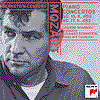 Bernstein recorded only three of the Mozart concertos for solo piano and orchestra, one of them twice. Working backward, his 1974 recording of the Concerto # 25 in C Major with the Israel Philharmonic (on volume 8 of the Royal Edition) is very slow (6 minutes longer than the usual half-hour) and deeply romanticized, including a highly unconventional melodramatic cadenza. His 1966 Concerto # 15 with the Vienna Philharmonic (now on London 448 570), is much more idiomatic, if a bit too refined and demure, as if Bernstein were trying just a bit too hard to ingratiate himself with that prestigious orchestra (as indeed he was in this early stage of their honeymoon). These 1956 recordings are his most brash and exciting; while respectful of Mozart, they project Bernstein's personality more fully, the chamber sonority enlivened with liberties of dynamics and tempo. The mono recording is vivid and clear, although hardly of the caliber of the Vienna session. Bernstein recorded only three of the Mozart concertos for solo piano and orchestra, one of them twice. Working backward, his 1974 recording of the Concerto # 25 in C Major with the Israel Philharmonic (on volume 8 of the Royal Edition) is very slow (6 minutes longer than the usual half-hour) and deeply romanticized, including a highly unconventional melodramatic cadenza. His 1966 Concerto # 15 with the Vienna Philharmonic (now on London 448 570), is much more idiomatic, if a bit too refined and demure, as if Bernstein were trying just a bit too hard to ingratiate himself with that prestigious orchestra (as indeed he was in this early stage of their honeymoon). These 1956 recordings are his most brash and exciting; while respectful of Mozart, they project Bernstein's personality more fully, the chamber sonority enlivened with liberties of dynamics and tempo. The mono recording is vivid and clear, although hardly of the caliber of the Vienna session.
- Berlioz: Symphonie Fantastique (1963) (SMK 60968).
 This disc was a surprise, but not the discovery I had been led to expect. Both the back of the jewel box and a special red sticker on the cover proclaim this to be the first CD release of Bernstein's 1963 version which, in a brief fit of von-Karajanism, he recut in 1968. Volume 12 of the Royal Edition states that it contains the 1968 version, so I looked forward to comparing the two. But it soon became apparent that they were in fact the same. And sure enough -- the 1968 LP (MS-7278) revealed a strikingly different performance. So I now have one performance for the price of two and still await CD release of the 1968 reworking, which is tighter, better-recorded and generally more dramatic (except for a tame ending). Oh, well. The present disc is filled out with "Berlioz Takes a Trip," originally a free bonus 7" disc, in which Bernstein traces the idee fixe. Ironically, its musical examples are more vivid than the corresponding sections of the actual performance. Bottom line: if you have the Royal Edition of this performance (1963!), stick with it -- the sound's better and it includes 24 minutes of extra music. And if Sony ever releases a disc boasting that it's the first CD issue of the 1968 performance Ö This disc was a surprise, but not the discovery I had been led to expect. Both the back of the jewel box and a special red sticker on the cover proclaim this to be the first CD release of Bernstein's 1963 version which, in a brief fit of von-Karajanism, he recut in 1968. Volume 12 of the Royal Edition states that it contains the 1968 version, so I looked forward to comparing the two. But it soon became apparent that they were in fact the same. And sure enough -- the 1968 LP (MS-7278) revealed a strikingly different performance. So I now have one performance for the price of two and still await CD release of the 1968 reworking, which is tighter, better-recorded and generally more dramatic (except for a tame ending). Oh, well. The present disc is filled out with "Berlioz Takes a Trip," originally a free bonus 7" disc, in which Bernstein traces the idee fixe. Ironically, its musical examples are more vivid than the corresponding sections of the actual performance. Bottom line: if you have the Royal Edition of this performance (1963!), stick with it -- the sound's better and it includes 24 minutes of extra music. And if Sony ever releases a disc boasting that it's the first CD issue of the 1968 performance Ö
- Berlioz: Harold in Italy, with William Linzer; La Mort de Cleopatre, with Jennie Tourel (SMK 60696).
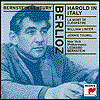 Harold is an electrifying reading that captures the raw passion of Berlioz better than any other. Throwing caution to the winds, Bernstein and Linzer (the Philharmonic's first-chair violist) are rough, edgy and incredibly exciting, eschewing entirely the refinement that passes for idiomatic Berlioz in other hands. Inexplicably omitted from the Royal Edition, this is one of the truly great Bernstein performances, giving Berlioz, the wild rebel of his time, his full due. It took a musician of Bernstein's youthful boldness to defy our established tradition to restore the composer's essential spirit. (Cleopatre, already in the Royal set, is a wonderful performance of Berlioz's early cantata.)
- Dvorak: Symphony # 7 in d minor; Smetana: Overture and Dances from "The Bartered Bride," The Moldau (SMK 60561).
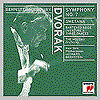 This is a very slow performance, and yet it never plods; indeed, it's quite graceful, infused with infectious, if deliberate, dance accents. Although few could have suspected at the time, we now can see in this 1963 reading the seeds of Bernstein's final style, in which tempos plummeted (but never at the expense of the music's soul). The 1964 Moldau (in the Royal Edition) is also a harbinger, but a less fortunate one - its blurry sound heralded Columbia's mid-'sixties acoustic. The "Bartered Bride" excerpts are spirited and fine. This is a very slow performance, and yet it never plods; indeed, it's quite graceful, infused with infectious, if deliberate, dance accents. Although few could have suspected at the time, we now can see in this 1963 reading the seeds of Bernstein's final style, in which tempos plummeted (but never at the expense of the music's soul). The 1964 Moldau (in the Royal Edition) is also a harbinger, but a less fortunate one - its blurry sound heralded Columbia's mid-'sixties acoustic. The "Bartered Bride" excerpts are spirited and fine.
- Goldmark: Rustic Wedding Symphony. Dvorak: Slavonic Dances, Op 26, Nos. 1 and 3. Humperdinck:
Children's Prayer from "Hansel und Gretel." Smetana: Three Dances from "The Bartered Bride."
SMK 61836.
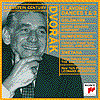 Aaaah. That's the sound of my esthetic side reacting to Bernstein's heartfelt rendition of the Rustic
Wedding Ė not really a symphony at all, but rather a theme and variations, followed by four tone
poems, all relaxed, lyric, melodious and intensely gorgeous. AAARRRGH! That's the sound of
my consumer side reacting to the outrage of the rest of this volume. Until now (October 1999), it
was frustrating enough that Sony took several volumes of the Bernstein Century edition that gave
us the CD debuts of several fine performances and padded them with reissues of material which
Bernstein fans had already scooped up in the Royal Edition. Here, though, the Dvorak and
Smetana filler is duplicated from other volumes in the Bernstein Century itself! Another problem Ė
the spine reads "DVORAK: SLAVONIC DANCES NOS. 1 & 3, ETC." Well, here the "etc." just
happens to be a 44-minute symphony while the listed works are the encores. Hello, Sony Ė
anybody home? It's not a big deal by itself, but along with the needless programming redundancy
and perfunctory notes signals waning attention to this series. Especially now that Sony just upped
the price another dollar, both consumers and Bernstein fans deserve better.
Aaaah. That's the sound of my esthetic side reacting to Bernstein's heartfelt rendition of the Rustic
Wedding Ė not really a symphony at all, but rather a theme and variations, followed by four tone
poems, all relaxed, lyric, melodious and intensely gorgeous. AAARRRGH! That's the sound of
my consumer side reacting to the outrage of the rest of this volume. Until now (October 1999), it
was frustrating enough that Sony took several volumes of the Bernstein Century edition that gave
us the CD debuts of several fine performances and padded them with reissues of material which
Bernstein fans had already scooped up in the Royal Edition. Here, though, the Dvorak and
Smetana filler is duplicated from other volumes in the Bernstein Century itself! Another problem Ė
the spine reads "DVORAK: SLAVONIC DANCES NOS. 1 & 3, ETC." Well, here the "etc." just
happens to be a 44-minute symphony while the listed works are the encores. Hello, Sony Ė
anybody home? It's not a big deal by itself, but along with the needless programming redundancy
and perfunctory notes signals waning attention to this series. Especially now that Sony just upped
the price another dollar, both consumers and Bernstein fans deserve better.
- "Great Marches" - Sousa: Semper Fidelis, The Thunderer, The Washington Post, Hands Across the Sea, The Stars and Stripes Forever; Strauss: Radetsky March; J. F. Wagner: Under the Double Eagle; Steffe/Howe: Battle Hymn of the Republic; Zimmerman: Anchors Aweigh; [Traditional:] The British Grenadiers; Arne: Rule, Britannia; De Lisle: La Marseillaise; Bagley: The National Emblem; Berlioz: Rakoczy March; Bizet: March of the Toreadors (from Carmen); Meyerbeer: Coronation March (from Le Prophete); Prokofiev: Maarch (from The Love of Three Oranges); Mendelssohn: War March of the Priests (from Althalie); Verdi: Grand March (from Aida); Ippolitov-Ivanov: Procession of the Sardar; Hindemith: March (from Symphonic Metamorphses); Elgar: Pomp and Circumstance March # 1; Wagner: Fest March (from Tannhauser); Alford: Colonel Bogey (SMK 63154).
 The wide variety of material and the excellence of the performances tempers the numbing prospect of 78 minutes (not 71, as the cover states) of nothing but marches. (Hey, I'm not a snob - I'd say the same about 78 minutes of tenor arias.) All the excerpts from serious stuff except the Meyerbeer were in the Royal Edition, but the ceremonial marches and anthems are all new to CD. Not essential Bernstein, perhaps, but a delightful light classical sampler that also serves as a fine reminder of Bernstein's versatility, as each piece, from stately Elgar to ecstatic Sousa, is played in its own appropriate style. The wide variety of material and the excellence of the performances tempers the numbing prospect of 78 minutes (not 71, as the cover states) of nothing but marches. (Hey, I'm not a snob - I'd say the same about 78 minutes of tenor arias.) All the excerpts from serious stuff except the Meyerbeer were in the Royal Edition, but the ceremonial marches and anthems are all new to CD. Not essential Bernstein, perhaps, but a delightful light classical sampler that also serves as a fine reminder of Bernstein's versatility, as each piece, from stately Elgar to ecstatic Sousa, is played in its own appropriate style.
- Mahler: Symphony # 2 ("Resurrection") (1963); Symphony # 5, Fourth Movement (1968); Symphony # 8 ("Symphony of a Thousand"), Part One (1962) (SM2K 63159).
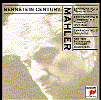 The Resurrection was always special to Bernstein, as well it should have been, one of the most emotionally draining and staggering conceptions in all of western music. His valedictory 1987 concert recording, also with the Philharmonic (on DG 423 395) seethes with power and energy. This first recording radiates a different but equally effective type of snarling, coiled energy. The occasion on which this Adagietto from the Mahler Fifth was recorded live (at the mass preceding Robert F. Kennedy's burial) is more auspicious than the performance, beautiful enough but better heard embedded in context in one of Bernstein's fine readings of the complete symphony of which it is an integral part. Part I of the Eighth commemorates a far more joyous occasion - the inauguration of the Philharmonic's new home in New York's Lincoln Center. While it would do honor to most other conductors, it's not as sharply focussed as the 1966 record of the entire work (on SM3K 47581). The Resurrection was always special to Bernstein, as well it should have been, one of the most emotionally draining and staggering conceptions in all of western music. His valedictory 1987 concert recording, also with the Philharmonic (on DG 423 395) seethes with power and energy. This first recording radiates a different but equally effective type of snarling, coiled energy. The occasion on which this Adagietto from the Mahler Fifth was recorded live (at the mass preceding Robert F. Kennedy's burial) is more auspicious than the performance, beautiful enough but better heard embedded in context in one of Bernstein's fine readings of the complete symphony of which it is an integral part. Part I of the Eighth commemorates a far more joyous occasion - the inauguration of the Philharmonic's new home in New York's Lincoln Center. While it would do honor to most other conductors, it's not as sharply focussed as the 1966 record of the entire work (on SM3K 47581).
- Mahler: Ruckert-Lieder; Lieder und Gesange; Lieder eines fahrenden Gesellen (all 1968). With Dietrich Fischer-Dieskau, baritone and Leonard Bernstein, piano. SMK 61847.
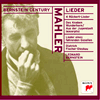 This set is very special, as these performances provide a wonderful complement to the orchestral versions of the Ruckert-Lieder and the Lieder eines fahrenden Gesellen which Bernstein recorded with Thomas Hampson and the Vienna Philharmonic at the very end of his career (DG 431 682-2). Although missing the varied texture, sustained tone and occasional sheer power of the instrumentation, these readings gain by achieving a profound intimacy as Bernstein applies his superbly sensitive pianism to balance the exquisitely varied nuance of the world's consummate lieder artist. They also display a degree of freedom that goes even beyond the unfettered personal expression that galvanizes Bernstein's magnificent Mahler series. To cite just a single example, at the opening of “Wenn mein Schatz,” Bernstein leaps ahead to answer each stabbing line of text far more impulsively than he could when conducting a full orchestra. Perhaps this is nothing more than the natural function of a solo accompanist's ability to ignore inhibition and to play directly without the need to worry about coordinating a hundred other musicians. In any event, the result is deeply affecting. The other eleven Lieder und Gesange are less familiar but equally welcome. This set is very special, as these performances provide a wonderful complement to the orchestral versions of the Ruckert-Lieder and the Lieder eines fahrenden Gesellen which Bernstein recorded with Thomas Hampson and the Vienna Philharmonic at the very end of his career (DG 431 682-2). Although missing the varied texture, sustained tone and occasional sheer power of the instrumentation, these readings gain by achieving a profound intimacy as Bernstein applies his superbly sensitive pianism to balance the exquisitely varied nuance of the world's consummate lieder artist. They also display a degree of freedom that goes even beyond the unfettered personal expression that galvanizes Bernstein's magnificent Mahler series. To cite just a single example, at the opening of “Wenn mein Schatz,” Bernstein leaps ahead to answer each stabbing line of text far more impulsively than he could when conducting a full orchestra. Perhaps this is nothing more than the natural function of a solo accompanist's ability to ignore inhibition and to play directly without the need to worry about coordinating a hundred other musicians. In any event, the result is deeply affecting. The other eleven Lieder und Gesange are less familiar but equally welcome.
- Debussy: Le Martyr de St. Sebastian, with Fritz Weaver and Felicia Montealegre, narrators (SMK 60596).
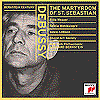 Please see the first part of the column for my decidedly mixed feelings about this performance - potentially one of Bernstein's greatest, and yet one of his excruciating worst. I only wish that the CD had provided separate tracks to allow programming of the magnificent music while bypassing the agonizing histrionics, but unfortunately the two remain intimately wedded. I had hoped to prepare a more intelligent comment, but I simply can't bear to listen to it any more. Please see the first part of the column for my decidedly mixed feelings about this performance - potentially one of Bernstein's greatest, and yet one of his excruciating worst. I only wish that the CD had provided separate tracks to allow programming of the magnificent music while bypassing the agonizing histrionics, but unfortunately the two remain intimately wedded. I had hoped to prepare a more intelligent comment, but I simply can't bear to listen to it any more.
- "20th Century French Masterpieces" - Dukas: Sorcerer's Apprentice; Honegger: Rugby, Pastorale d'Ete, Pacific 231; Debussy: Rhapsody for Saxophone and Orchestra, with Sigurd Rascher; Milhaud: La Creation du Monde, with the Columbia Chamber Orchestra (1951); Ravel: Sheherazade, with Jennie Tourel and the Columbia Symphony Orchestra (1950) (SMK 60695).
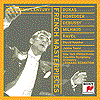 Honegger's three rhythmic studies are right up Bernstein's alley, and he and the Philharmonic play them magnificently. The unusual Debussy is remarkable, presenting the rude honking quintessential rock 'n' roll instrument in a lush and verdant sensitive mood; written in 1910, it's also one of the very earliest attempts to integrate jazz elements into traditional serious art music, long predating the more famous efforts of Gershwin, Stravinsky and others. The Ravel sounds inappropriately lean and scrappy compared to the lush sensuality of Bernstein's 1975 remake with Marilyn Horne and the Orchestre National de France (on volume 66 of the Royal Edition). The Milhaud has the distinction of being Bernstein's first remake, as he'd already recorded it with the Victor Chamber Orchestra only six years earlier for RCA (now on RCA CD 68101); either version is fine and preferable to a yet later remake for EMI in 1978 (last on EMI 47845), which sounds too refined and arty for music of such intrinsic spirit. As for the Dukas, why is it even here on a set devoted to the 20th century? Aside from already being on the Royal Edition, it was written in 1897! Honegger's three rhythmic studies are right up Bernstein's alley, and he and the Philharmonic play them magnificently. The unusual Debussy is remarkable, presenting the rude honking quintessential rock 'n' roll instrument in a lush and verdant sensitive mood; written in 1910, it's also one of the very earliest attempts to integrate jazz elements into traditional serious art music, long predating the more famous efforts of Gershwin, Stravinsky and others. The Ravel sounds inappropriately lean and scrappy compared to the lush sensuality of Bernstein's 1975 remake with Marilyn Horne and the Orchestre National de France (on volume 66 of the Royal Edition). The Milhaud has the distinction of being Bernstein's first remake, as he'd already recorded it with the Victor Chamber Orchestra only six years earlier for RCA (now on RCA CD 68101); either version is fine and preferable to a yet later remake for EMI in 1978 (last on EMI 47845), which sounds too refined and arty for music of such intrinsic spirit. As for the Dukas, why is it even here on a set devoted to the 20th century? Aside from already being on the Royal Edition, it was written in 1897!
- Respighi: The Pines of Rome; Roman Festivals (SMK 60174).
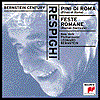 At a chintzy 46 minutes, this bears the dubious distinction of being the shortest Bernstein disc Sony has yet released; perhaps it's no accident that it's the only one without a timing listed on the back cover. Of the little that's here, we have fine but hardly unique full-bodied readings of these two flashy, instantly-appealing scores. At a chintzy 46 minutes, this bears the dubious distinction of being the shortest Bernstein disc Sony has yet released; perhaps it's no accident that it's the only one without a timing listed on the back cover. Of the little that's here, we have fine but hardly unique full-bodied readings of these two flashy, instantly-appealing scores.
- Ives: The Unanswered Question, Holidays Symphony, Central Park in the Dark; Carter: Concerto For Orchestra (SMK 60203)
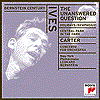 Hailed as an American hero, it was perhaps natural for Bernstein to champion Charles Ives who, for all his precociously modern techniques, was deeply immersed in America's traditional music and values. An outrageous omission from the Royal Edition, his Holidays Symphony is a strikingly diverse package of reverent hymns, marching bands, noisy celebration, wondrous awe and rollicking humor which Bernstein and the Philharmonic play to the hilt. Even more welcome is The Unanswered Question, a work which could be easily described but really has to be heard to convey the full effect of its eloquence and profundity. It's perhaps one of the very few thoroughly modern works that packs a devastating emotional impact. In 5-1/2 minutes it says more about the human condition than Wagner conveyed in a lifetime. The Carter Concerto is an exhausting work, constantly throwing off sparks of energy during its single 24-minute movement, and yet fascinating in its kaleidoscopic orchestration.. Perhaps the most modern-sounding work Bernstein recorded, it takes several hearings to approach its rewards, but is well worth the effort. Hailed as an American hero, it was perhaps natural for Bernstein to champion Charles Ives who, for all his precociously modern techniques, was deeply immersed in America's traditional music and values. An outrageous omission from the Royal Edition, his Holidays Symphony is a strikingly diverse package of reverent hymns, marching bands, noisy celebration, wondrous awe and rollicking humor which Bernstein and the Philharmonic play to the hilt. Even more welcome is The Unanswered Question, a work which could be easily described but really has to be heard to convey the full effect of its eloquence and profundity. It's perhaps one of the very few thoroughly modern works that packs a devastating emotional impact. In 5-1/2 minutes it says more about the human condition than Wagner conveyed in a lifetime. The Carter Concerto is an exhausting work, constantly throwing off sparks of energy during its single 24-minute movement, and yet fascinating in its kaleidoscopic orchestration.. Perhaps the most modern-sounding work Bernstein recorded, it takes several hearings to approach its rewards, but is well worth the effort.
- Copland: Symphony # 3 (1966); Symphony for Organ and Orchestra, with E. Power Biggs (SMK 63155).
 The Third Symphony is the most popular of Copland's serious works, invoking visions of an idealized America, with its bold pioneers and wondrous wide open vistas. The last movement, in particular, resonates with the famous "Common Man" fanfare. Needless to say, Bernstein, a close student and associate of Copland, provides a magnificent performance. The rarer Symphony for Organ is a deliriously precocious work, played to the hilt. The Third Symphony is the most popular of Copland's serious works, invoking visions of an idealized America, with its bold pioneers and wondrous wide open vistas. The last movement, in particular, resonates with the famous "Common Man" fanfare. Needless to say, Bernstein, a close student and associate of Copland, provides a magnificent performance. The rarer Symphony for Organ is a deliriously precocious work, played to the hilt.
- Copland: Music for the Theatre (1958); Concerto for Piano and Orchestra, with Aaron Copland, piano; Connotations for Orchestra; El Salon Mexico, with the Columbia Symphony Orchestra (1950) (SMK 60177).
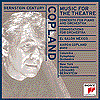 This CD provides a fine overview of Copland's work in wonderful performances by his protégé. The Music for the Theatre suite of five pieces is itself a neat microcosm of Copland's distinctive style, from the sly and playful to the evocative and wistful. The Piano Concerto is jazzy and brash, and receives a definitive performance with the composer at the keyboard and his most ardent advocate on the podium. Connotations is the most forbidding and difficult of Copland's orchestral scores, its bravura display of orchestral textures suited to the occasion of its premiere at the dedication of the Lincoln Center concert hall in 1962, at which this performance was recorded live by its resident orchestra. El Salon Mexico, on the other hand, is Copland's most accessible work, an American tourist's mythical dreamscape of Mexican dance-hall rhythms. This 1951 performance is nearly identical to, but the sound and energy level can't quite match, the 1961 Philharmonic stereo remake. This CD provides a fine overview of Copland's work in wonderful performances by his protégé. The Music for the Theatre suite of five pieces is itself a neat microcosm of Copland's distinctive style, from the sly and playful to the evocative and wistful. The Piano Concerto is jazzy and brash, and receives a definitive performance with the composer at the keyboard and his most ardent advocate on the podium. Connotations is the most forbidding and difficult of Copland's orchestral scores, its bravura display of orchestral textures suited to the occasion of its premiere at the dedication of the Lincoln Center concert hall in 1962, at which this performance was recorded live by its resident orchestra. El Salon Mexico, on the other hand, is Copland's most accessible work, an American tourist's mythical dreamscape of Mexican dance-hall rhythms. This 1951 performance is nearly identical to, but the sound and energy level can't quite match, the 1961 Philharmonic stereo remake.
- Copland: The Second Hurricane, with soloists and chorus of the High School of Music and the Arts, New York City; In the Beginning, with Martha Lipton, mezzo-soprano and the Chorus Pro Musica (SMK 60560).
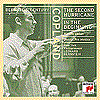 Apparently, the Bernstein Century aims to issue every scrap Bernstein recorded for Columbia. Although this will prove invaluable for archivists and fanatics (myself included), Bernstein's wide range of activity produced some pretty marginal stuff. The Second Hurricane was written in 1936 for a high school performance (directed by Orson Welles!) but the painfully trite libretto seems more like one of those grade-school pageants that charm doting parents while their little Jimmy or Suzie is up on the stage, but otherwise is pretty grim. Copland's music, though, is full of fine, unpretentious touches. The dozen musical numbers begin each of the CD tracks, so you can skip most of the stilted dramatic interludes; otherwise, the overall effect is pretty doleful. In the Beginning is a colorful but reverent a cappella setting of scripture, written for the Robert Shaw Chorale in 1947. Apparently, the Bernstein Century aims to issue every scrap Bernstein recorded for Columbia. Although this will prove invaluable for archivists and fanatics (myself included), Bernstein's wide range of activity produced some pretty marginal stuff. The Second Hurricane was written in 1936 for a high school performance (directed by Orson Welles!) but the painfully trite libretto seems more like one of those grade-school pageants that charm doting parents while their little Jimmy or Suzie is up on the stage, but otherwise is pretty grim. Copland's music, though, is full of fine, unpretentious touches. The dozen musical numbers begin each of the CD tracks, so you can skip most of the stilted dramatic interludes; otherwise, the overall effect is pretty doleful. In the Beginning is a colorful but reverent a cappella setting of scripture, written for the Robert Shaw Chorale in 1947.
- "American Masters" - Harris: Symphony # 3 (1961); Thompson: Symphony # 2; Diamond: Symphony # 4 (SMK 60594).
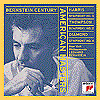 Beautifully played and recorded, this collection is a testament to the vitality of the oft-maligned (or ignored) genre of American classical music. Even though these symphonies are essentially conservative and clearly modeled on European forms, they all have the sound and feel of America - big, flashy and powerful, yet gentle, wistful and evocative. In other hands they can seem derivative and trite, but not with the focus and devotion of these impassioned realizations. Beautifully played and recorded, this collection is a testament to the vitality of the oft-maligned (or ignored) genre of American classical music. Even though these symphonies are essentially conservative and clearly modeled on European forms, they all have the sound and feel of America - big, flashy and powerful, yet gentle, wistful and evocative. In other hands they can seem derivative and trite, but not with the focus and devotion of these impassioned realizations.
- "American Masters 2" - Piston: The Incredible Flutist; Blitzstein: Airborne Symphony, with Orson Welles, narrator, Andrea Vells, tenor, David Watson, baritone and the Choral Art Society (1966); Hill: Prelude for Orchestra, with the Columbia Symphony Orchestra (SMK 61849).
 Bernstein was a man of depth and complexity, full of contradictions. One I have never been able to fathom is why in the world he was so drawn to Marc Blitzstein's Airborne Symphony, a dreadful period piece that sounds like mass-produced socialist drivel from Russia or China after their so-called cultural revolutions (which in fact were artistically reactionary). Bernstein recorded it in 1946 as one of his first studio projects (now on RCA 62568) and again in 1966 as one of his very few remakes of modern music (beyond Copland and his own). Clearly, Bernstein wanted to advocate the music of his close friend, but why, oh why, couldn't he have chosen something more worthy of his reputation (like a suite from his "The Cradle Will Rock," which had ignited Bernstein's social activism in college)? If you can bear it, this performance is preferred for its better sound and subtler narration by Orson Welles. The other two pieces pay professional tribute to two of Bernstein's most influential teachers. While The Incredible Flutist is Walter Piston's most popular work, it's atypical of his disciplined outlook. Edward Burlingame Hill's Prelude is a derivative piece of Impressionism but lovely, efficient, unpretentious and sincere (ie: everything the Airborne is not) and appears to be the only one of his works ever recorded. Bernstein was a man of depth and complexity, full of contradictions. One I have never been able to fathom is why in the world he was so drawn to Marc Blitzstein's Airborne Symphony, a dreadful period piece that sounds like mass-produced socialist drivel from Russia or China after their so-called cultural revolutions (which in fact were artistically reactionary). Bernstein recorded it in 1946 as one of his first studio projects (now on RCA 62568) and again in 1966 as one of his very few remakes of modern music (beyond Copland and his own). Clearly, Bernstein wanted to advocate the music of his close friend, but why, oh why, couldn't he have chosen something more worthy of his reputation (like a suite from his "The Cradle Will Rock," which had ignited Bernstein's social activism in college)? If you can bear it, this performance is preferred for its better sound and subtler narration by Orson Welles. The other two pieces pay professional tribute to two of Bernstein's most influential teachers. While The Incredible Flutist is Walter Piston's most popular work, it's atypical of his disciplined outlook. Edward Burlingame Hill's Prelude is a derivative piece of Impressionism but lovely, efficient, unpretentious and sincere (ie: everything the Airborne is not) and appears to be the only one of his works ever recorded.
- "Modern Masters" - Lopatnikoff: Concertino for Orchestra; Dallapiccola: Tartiniana for Violin and Orchestra, with Ruth Posselt; Shapero: Symphony for Classical Orchestra; all with the Columbia Symphony Orchestra (SMK 60725).
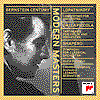 Anyone who accuses Bernstein of pandering to popular taste should consider this collection of neoclassic obscurities. The Lopatnikoff is pleasant, lyric and playful, while the Dallapiccola echoes Stravinsky's Pulcinella with Tartini violin sonatas but comes off stolid and humorless. Far more interesting is the Shapero Symphony - although still based on classical models, it's larger-scaled and magnificent and fits well within the great symphonic tradition. Bernstein and his players seem more engaged as well. Even though none of these works have "masterpiece" written all over them, they're well worth hearing and I'd rather have their only recordings than a hundredth disc of a Beethoven symphony. Anyone who accuses Bernstein of pandering to popular taste should consider this collection of neoclassic obscurities. The Lopatnikoff is pleasant, lyric and playful, while the Dallapiccola echoes Stravinsky's Pulcinella with Tartini violin sonatas but comes off stolid and humorless. Far more interesting is the Shapero Symphony - although still based on classical models, it's larger-scaled and magnificent and fits well within the great symphonic tradition. Bernstein and his players seem more engaged as well. Even though none of these works have "masterpiece" written all over them, they're well worth hearing and I'd rather have their only recordings than a hundredth disc of a Beethoven symphony.
- Barber: Adagio for Strings (1971), Violin Concerto, with Isaac Stern; Schuman: In Praise of Shahn, To Thee Old Cause (SMK 63088).
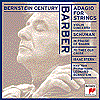 Samuel Barber's Adagio for Strings, an arrangement for string orchestra of a movement of his Quartet, was hugely popular, even before its use in Platoon, as well it should be. Poignant, searching and unsettling yet ultimately peaceful, it's an incredibly moving and effective piece of music. The Violin Concerto is a gorgeous, lush, virtuostic work, which Stern and Bernstein play to the hilt. The two works by William Schuman are lesser-known elegies -- In Praise of Shahn is a remembrance of the background and outlook of the late artist, while To Thee Old Cause is a deeply-felt and extraordinary response to the King and Kennedy assassinations. Samuel Barber's Adagio for Strings, an arrangement for string orchestra of a movement of his Quartet, was hugely popular, even before its use in Platoon, as well it should be. Poignant, searching and unsettling yet ultimately peaceful, it's an incredibly moving and effective piece of music. The Violin Concerto is a gorgeous, lush, virtuostic work, which Stern and Bernstein play to the hilt. The two works by William Schuman are lesser-known elegies -- In Praise of Shahn is a remembrance of the background and outlook of the late artist, while To Thee Old Cause is a deeply-felt and extraordinary response to the King and Kennedy assassinations.
- Schuman: Symphony # 3; Symphony For Strings in Three Movements; Symphony # 8 (SMK 65163).
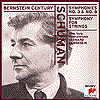 When invited to provide program notes for the 1962 premiere of his Symphony # 8, Schuman responded by deriding the notion of "play-by-play accounts," "complicated polemics for particular aesthetic creeds," and "preoccupation with descriptions of techniques" that place composers in categories and prejudge their work in ways that have nothing do with excellence. Out of deference to the composer, I won't even try to describe these magnificent works, but would simply note that this volume affords a generous selection from one of America's greatest symphonists, presented with devotion and understanding by an orchestra and conductor with whom he was closely associated. When invited to provide program notes for the 1962 premiere of his Symphony # 8, Schuman responded by deriding the notion of "play-by-play accounts," "complicated polemics for particular aesthetic creeds," and "preoccupation with descriptions of techniques" that place composers in categories and prejudge their work in ways that have nothing do with excellence. Out of deference to the composer, I won't even try to describe these magnificent works, but would simply note that this volume affords a generous selection from one of America's greatest symphonists, presented with devotion and understanding by an orchestra and conductor with whom he was closely associated.
- Foss: Time Cycle, with Adele Addison, soprano and the Columbia Symphony Orchestra; Phorion; Song of Songs, with Jennie Tourel, mezzo-soprano (SMK 63164).
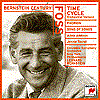 The works here are as different as can be, even though they stemmed from the same creative mind within a period of two decades. In a structural sense, Time Cycle is perhaps the most unusual work Bernstein recorded, consisting as it does of four songs to texts by Auden, Housmann, Kafka and Neitzche, separated by orchestral improvisations. The recording is not by the New York Philharmonic but by the so-called "Columbia Symphony Orchestra," essentially a pick-up group of moonlighting Philharmonic musicians whose work may not necessarily reflect the improvisatory energy of the premiere, which so excited Bernstein that he had the work repeated on the spot. Song of Songs (already in the Royal Edition) is a gorgeous, lush conservative Biblical meditation. Phorion bursts with purposeful humor. It takes the idea of the tone row (in which an entire composition is based on a specific ordering of the notes of the chromatic scale) a witty step further -- the only musical materials used here are phrases from a Bach solo violin partita, which descend from playful hilarity to glaring brutality. The works here are as different as can be, even though they stemmed from the same creative mind within a period of two decades. In a structural sense, Time Cycle is perhaps the most unusual work Bernstein recorded, consisting as it does of four songs to texts by Auden, Housmann, Kafka and Neitzche, separated by orchestral improvisations. The recording is not by the New York Philharmonic but by the so-called "Columbia Symphony Orchestra," essentially a pick-up group of moonlighting Philharmonic musicians whose work may not necessarily reflect the improvisatory energy of the premiere, which so excited Bernstein that he had the work repeated on the spot. Song of Songs (already in the Royal Edition) is a gorgeous, lush conservative Biblical meditation. Phorion bursts with purposeful humor. It takes the idea of the tone row (in which an entire composition is based on a specific ordering of the notes of the chromatic scale) a witty step further -- the only musical materials used here are phrases from a Bach solo violin partita, which descend from playful hilarity to glaring brutality.
- "Music of Our Time" - Ligeti: Atmospheres; Feldman: Out of “Last Pieces"; "Four Improvisations by the Orchestra"; Denisov: Crescendo e Diminuendo; Schuller: Triplum; Messian: Trois Petites Liturgies de la Presence Divine, with Paul Jacobs, piano, John Canarina, ondes martenot, and the Womenís Chorus of the Choral Arts Society. (SMK 61845).
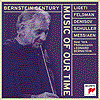 Bernsteinís own music had modern elements but was firmly anchored in traditional tonality and structure. Perhaps it was to complement his own inclinations as a composer that he turned to more overtly modern stuff. Messianís lovely, flowing piece for female chorus and reduced orchestra (plus piano and the ethereal "ondes martinot") really doesnít belong here, but its similarity to Bernsteinís own religious works reveals the reason for his affinity. The magnificent Ligeti, though, is true to its title. Itís all about textures and cosmic sonic events. The problem with the other works is exemplified by the four orchestral improvisations. The musicians are basically fooling around (albeit with some preplanning), but the results sound strikingly similar to the composed pieces. Thatís the fatal flaw with avant-garde music. By deliberately eschewing the standard reference points of melody, harmony and structure upon which we cling for our musical pleasure, thereís nothing left for us to grasp or to cherish. (But, of course, thatís what every generation says about the most advanced work of its time that inevitably moves into the mainstream.) In any event, this is a fine collection that serves as a neat summary of orchestral music at mid-century; itís also a tribute both to Bernsteinís depth as a complete musician and to the talent of the NYP musicians, who realize these challenging pieces with brilliance and enthusiasm. Bernsteinís own music had modern elements but was firmly anchored in traditional tonality and structure. Perhaps it was to complement his own inclinations as a composer that he turned to more overtly modern stuff. Messianís lovely, flowing piece for female chorus and reduced orchestra (plus piano and the ethereal "ondes martinot") really doesnít belong here, but its similarity to Bernsteinís own religious works reveals the reason for his affinity. The magnificent Ligeti, though, is true to its title. Itís all about textures and cosmic sonic events. The problem with the other works is exemplified by the four orchestral improvisations. The musicians are basically fooling around (albeit with some preplanning), but the results sound strikingly similar to the composed pieces. Thatís the fatal flaw with avant-garde music. By deliberately eschewing the standard reference points of melody, harmony and structure upon which we cling for our musical pleasure, thereís nothing left for us to grasp or to cherish. (But, of course, thatís what every generation says about the most advanced work of its time that inevitably moves into the mainstream.) In any event, this is a fine collection that serves as a neat summary of orchestral music at mid-century; itís also a tribute both to Bernsteinís depth as a complete musician and to the talent of the NYP musicians, who realize these challenging pieces with brilliance and enthusiasm.
- Bernstein: Symphony # 2 ("The Age of Anxiety"), with Lukas Foss, piano (1950); Serenade After Plato's "Symposium," with Isaac Stern and the Symphony of the Air (1956) (SMK 60558).
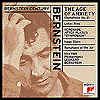 While few would dispute the greatness of Bernstein the theatre composer, his serious compositions are more controversial and less likely to survive him. The titles of these two works proclaim their sources (and, to detractors, their pretensions). If you're a fan, then his first recordings of his own works are doubly valuable. The Second Symphony was recorded right after its premiere and preserves the composer's own thoughts at the time. This is especially significant here, since Bernstein revised the work in 1965, and it is that version which was recorded in each of his remakes (for Columbia in 1965 and for DG with the Israel Philharmonic in 1977). The Serenade, too, receives its first and best reading here. While few would dispute the greatness of Bernstein the theatre composer, his serious compositions are more controversial and less likely to survive him. The titles of these two works proclaim their sources (and, to detractors, their pretensions). If you're a fan, then his first recordings of his own works are doubly valuable. The Second Symphony was recorded right after its premiere and preserves the composer's own thoughts at the time. This is especially significant here, since Bernstein revised the work in 1965, and it is that version which was recorded in each of his remakes (for Columbia in 1965 and for DG with the Israel Philharmonic in 1977). The Serenade, too, receives its first and best reading here.
- Bernstein: Prelude, Fugue and Riffs, with Benny Goodman, clarinet, and the Columbia Jazz Ensemble; On the Town (Three Dances) (1963); Serenade, with Zino Francescatti, violin (1965); Fancy Free - Ballet, with the Columbia Symphony Orchestra (1956) (SMK 60559).
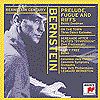 Delightful, unpretentious, witty and short, the Prelude, Fugue and Riffs is the star of this show. Written for and featuring Benny Goodman, it melds classical forms with the instrumental sound and improvisatory feel of jazz. The On the Town dances are already on volume 15 of the Royal Edition; it's a fine performance, but lacks the sassy zest of the 1945 RCA set made with the "On the Town Orchestra" and enhanced with two extra movements (now on RCA 60915). This 1965 Serenade is somewhat diffuse, without the energy of the 1954 original (on SMK 60558, above) or the exciting precision of the 1978 concert with Gideon Kremer and the Israel Philharmonic (on DG 423 583). Finally, there's Bernstein's first recording of Fancy Free; a decade after its premiere, it still sounds fresher than the more symphonic 1978 Israel Philharmonic version. Delightful, unpretentious, witty and short, the Prelude, Fugue and Riffs is the star of this show. Written for and featuring Benny Goodman, it melds classical forms with the instrumental sound and improvisatory feel of jazz. The On the Town dances are already on volume 15 of the Royal Edition; it's a fine performance, but lacks the sassy zest of the 1945 RCA set made with the "On the Town Orchestra" and enhanced with two extra movements (now on RCA 60915). This 1965 Serenade is somewhat diffuse, without the energy of the 1954 original (on SMK 60558, above) or the exciting precision of the 1978 concert with Gideon Kremer and the Israel Philharmonic (on DG 423 583). Finally, there's Bernstein's first recording of Fancy Free; a decade after its premiere, it still sounds fresher than the more symphonic 1978 Israel Philharmonic version.
- Bernstein: Trouble in Tahiti, with Nancy Williams, mezzo-soprano, Julian Patrick, bass-baritone, and the Columbia Wind Ensemble; Facsimile (1963) (SMK 60969).
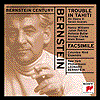 Bernstein's 1951 operetta is perhaps now best known as the flashback episode in his 1983 opera A Quiet Place (on DG 419 761), in which he sought to enrich his original snapshot of a day in a crumbling marriage by updating the lives of its dysfunctional couple and their offspring. Yet, the original material remains more poignant on its own in this, Bernstein's only (1973) recording. Despite fancying himself a writer, Bernstein's lyrics could be painfully trite, but his own libretto here is wonderful. So is the music: the opening bop trio is one of his most engaging tunes and the ending is honest and haunting. The 1946 ballet Facsimile was an attempt by Bernstein and choreographer Jerome Robbins to capitalize with a more serious work on the success of their Fancy Free; the plots are similar (guys try to pick up a girl) but with the emphasis shifted to boredom and melancholy. A first record with the RCA Victor Orchestra (now on RCA 61650) came a year later; although it's slightly more pointed, the sound is shrill and so this stereo remake is preferable. Bernstein's 1951 operetta is perhaps now best known as the flashback episode in his 1983 opera A Quiet Place (on DG 419 761), in which he sought to enrich his original snapshot of a day in a crumbling marriage by updating the lives of its dysfunctional couple and their offspring. Yet, the original material remains more poignant on its own in this, Bernstein's only (1973) recording. Despite fancying himself a writer, Bernstein's lyrics could be painfully trite, but his own libretto here is wonderful. So is the music: the opening bop trio is one of his most engaging tunes and the ending is honest and haunting. The 1946 ballet Facsimile was an attempt by Bernstein and choreographer Jerome Robbins to capitalize with a more serious work on the success of their Fancy Free; the plots are similar (guys try to pick up a girl) but with the emphasis shifted to boredom and melancholy. A first record with the RCA Victor Orchestra (now on RCA 61650) came a year later; although it's slightly more pointed, the sound is shrill and so this stereo remake is preferable.
- Bernstein: Dybbuk, with the New York City Ballet Orchestra (1974) (SMK 63090),
 This is the complete score to Bernstein's last ballet and his final collaboration with Jerome Robbins, who was there at the start of Bernstein's career ("Fancy Free," 1944) and at its apex ("West Side Story," 1957). This recording was made with the original forces three weeks after they gave the world premiere. According to the album notes, the composition was determined in large part by the mystical medieval Jewish system of numerology contained in the texts of the kaballah, but the results sound more conventional than such an approach would suggest. Indeed, after a bold opening reminiscent of the 1973 Mass, the work has a mostly conservative, traditional feeling. One melody in particular, associated with Leah, is unforgettable, even though it is heard unadorned only briefly. This is the complete score to Bernstein's last ballet and his final collaboration with Jerome Robbins, who was there at the start of Bernstein's career ("Fancy Free," 1944) and at its apex ("West Side Story," 1957). This recording was made with the original forces three weeks after they gave the world premiere. According to the album notes, the composition was determined in large part by the mystical medieval Jewish system of numerology contained in the texts of the kaballah, but the results sound more conventional than such an approach would suggest. Indeed, after a bold opening reminiscent of the 1973 Mass, the work has a mostly conservative, traditional feeling. One melody in particular, associated with Leah, is unforgettable, even though it is heard unadorned only briefly.
- Bernstein: Mass, with Alan Titus, the Norman Scribner Choir and the Berkshire Boy Choir (SM2K 63089).
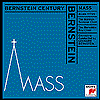 I've already shouted my huge enthusiasm for this magnificent tour de force in the main portion of this column, above. I can only add on a personal note that when I first heard Mass it blew me away and my affection for this fabulous work only continues to grow. And even if it is a dated product of its time, hey - that was my time! I've already shouted my huge enthusiasm for this magnificent tour de force in the main portion of this column, above. I can only add on a personal note that when I first heard Mass it blew me away and my affection for this fabulous work only continues to grow. And even if it is a dated product of its time, hey - that was my time!

Copyright 1999 and 2000 by Peter Gutmann
|